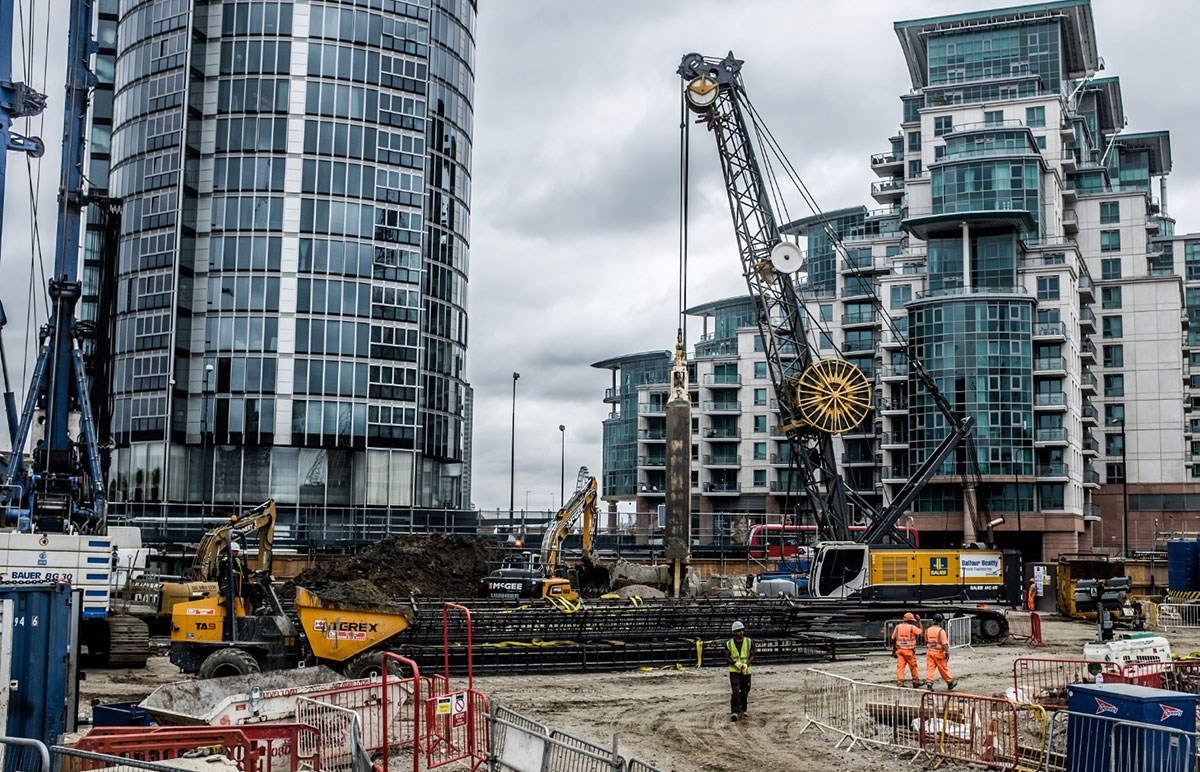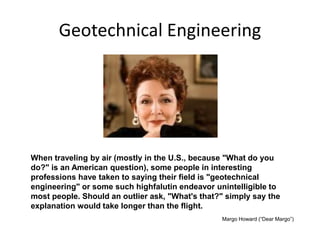More About Geotheta
More About Geotheta
Blog Article
Geotheta Things To Know Before You Buy
Table of Contents8 Simple Techniques For GeothetaExcitement About GeothetaThe smart Trick of Geotheta That Nobody is Talking AboutNot known Details About Geotheta
They team up with civil designers, architectural engineers, architects, and various other experts to integrate geotechnical considerations right into the general project design and building and construction procedure. This needs efficient team effort, coordination, and interaction to make sure that the geotechnical elements align with the task goals and meet governing demands.Mining & Materials Engineering: Concepts of drilling, penetration rates, and aspects impacting the option of drilling approach. Qualities of explosives, shooting systems and blast patterns. Blasting methods in surface and below ground workings. Unique blowing up methods at excavation perimeters. Vibration and sound control. Mechanical and constant strategies to fragmentation, including longwall shearing and fullface boring.
Modelling of piece and particle size circulations; comminution as a transfer feature. Comminution modern technology: squashing, grinding, size classification. Integrated evaluation of fragmentation and comminution procedures. Provided by: Mining & Materials Design.
Indicators on Geotheta You Should Know
Bachelor's degree programs in civil, geotechnical, geological, and environmental design generally last four years and include basic education and learning programs in English, social scientific research, and the humanities, as well as courses in advanced mathematics, structural geology, and fluid mineralogy. (https://myanimelist.net/profile/geotheta)
Geotechnical engineering includes the analysis of the dirt and rock conditions at a particular website, and their effects for the development of that site. As most structures depend on the ground for assistance, it lacks surprise that a comprehensive understanding of the ground conditions, and the viability of structure systems, are essential to the long-term stability and performance of the building or structure.
Specialising in the investigation of geological developments and ground practices, geotechnical designers execute clinical examinations and screening to recognize the impact these geological developments may carry the style and construction of structure, civil and infrastructure projects. This know-how is crucial for the design and construction of buildings, roads, passages, dams, bridges, and water system and sewer systems.
The geotechnical group at Douglas Partners regularly consult with architects, layout designers, programmers, and building contractors to make referrals on style and advancement proposals to make certain that the constructed frameworks are appropriately developed for the ground conditions. For instance, the layout of footing systems requires to think about the weight of the structure, the capacity of the ground to sustain that weight together with movement resistances and effective building.
Getting My Geotheta To Work
This task is substantially simplified by the usage of our Douglas Map geospatial platform that makes this details easily obtainable in a simple to make use of web browser interface. A geotechnical engineer will certainly direct the drilling of boreholes and test pits to gather dirt and other samples, and likewise examine surface functions and ground exposures to form a geotechnical version of the subsurface conditions.
Depending on the job type and ground problems experienced, laboratory testing may to name a few things examine toughness, compressibility, sensitivity and/or leaks in the structure of soil and rock examples. After this data is gathered and collated, the outcomes are utilized for a geotechnical model of the site, which is normally provided as areas across the website.

A geotechnical investigation by nature can just examine the ground conditions at the locations drilled or excavated. All-natural variations in dirt and rock conditions can take place across a website and in between examination places. It is therefore good method that the geotechnical designer be maintained throughout construction of the job to provide on-site verification that the ground conditions run into follow the assumptions and advice given in the geotechnical investigation record.
What Does Geotheta Mean?
Geotechnical engineers use their in-depth knowledge of dirt and rock to assess risk and solve issues on diverse framework projectsGeotechnical engineering is a specialist branch of civil engineering which looks at the behavior of earth products and the application of soil and rock technicians. Consulting Engineers. As a geotechnical designer, you will certainly examine the physical, mechanical and chemical homes of dirt and rock in order to develop structures, maintaining frameworks and earthworks
Geotechnical engineering is carefully linked to and overlaps with, both engineering geology and ground engineering - https://anotepad.com/note/read/ew8kqmw7. It's feasible to specialise in geotechnics or job for a geotechnical firm however be known as an engineering rock hound or a ground engineer. As a geotechnical engineer, you'll require to: build and maintain relationships with clients and various other professionals involved in the site, throughout each projectmaintain safety and security requirements on site be mindful of expense ramifications when you make recommendationsstudy geological maps and airborne photos Engineer of Record from a variety of sources and from different time periodsexamine building and construction intends to see how viable they are based upon your understanding of the siteinvestigate threats or geological dangers for the sitesearch for ecologically delicate features, such as land fill beginning to create factual and expository ground modelsplan area investigationsdrill and analyse examples of bedrock, soil, groundwater and extra materials manage various other professionals on sitesolve technological issues as they develop, such as unforeseen structures at drill sitesmonitor conditions during and after building and construction to ensure structures are steady in the brief and long termadding information collected on website to your first researchcreating geotechnical calculations, drawings, and 2 or three-dimensional computer system designs translating the datamaking suggestions concerning the suggested usage of the site

Report this page